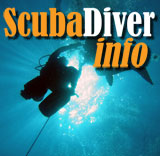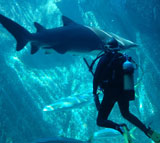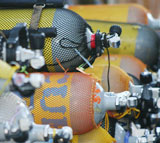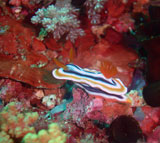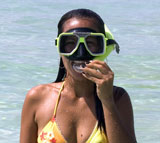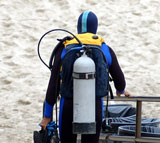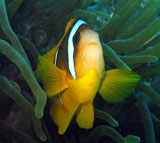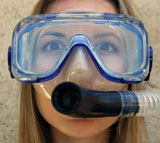Buoyancy Compensators (BCs)
by Conrad H. Blickenstorfer
What is a BC? Basically just an air bladder that you can inflate or deflate depending on how much buoyancy you need. 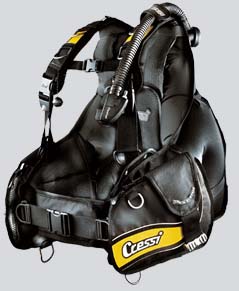 When you dive, your buoyancy changes with the depth you're at and also with the amount of air still in your tank. Since you don't want to constantly fight rising up or sinking down you need some sort of buoyancy compensation device, or a BC--a Buoyancy Compensator. Some people call them BCDs, or Buoyancy Control Devices. Same thing. The BC is a mandatory piece of safety equipment that every scuba diver must have. The BC shown on the right is a Cressi S111R. As you can see, BCs are fairly elaborate affairs that may include numerous functions and features, some of them optional. When you dive, your buoyancy changes with the depth you're at and also with the amount of air still in your tank. Since you don't want to constantly fight rising up or sinking down you need some sort of buoyancy compensation device, or a BC--a Buoyancy Compensator. Some people call them BCDs, or Buoyancy Control Devices. Same thing. The BC is a mandatory piece of safety equipment that every scuba diver must have. The BC shown on the right is a Cressi S111R. As you can see, BCs are fairly elaborate affairs that may include numerous functions and features, some of them optional.
BCs started out as simple life jackets designed to make a diver float face-up on the surface. They then morphed into front-mounted "horse collar" vests that tended to put divers off-balance and were hard to blow up. Today, BCs have evolved into ever more complex multi-functional systems that do all sorts of things other than just providing the proper buoyancy while diving and acting as safety flotation devices when a diver is on on the surface waiting for a pickup.
A modern BC has any number of functions and can have all sorts of accessories. The air tank attaches to the BC, as well as the regulator and alternate air supplies. Some BCs have many other attachments and add-ons, and each BC manufacturer has numerous patented and unique features to provide them with an edge.
Types of BCs
There are a variety of different types of BCs. Each type affects underwater movement, buoyancy control, floating behavior and your ability to carry things. Different manufacturers use different terminologies to describe their designs, so the categories we're listing here may be known by different names.
Back Mount BCs, sometimes called "wings" or "Back Flotation Jackets," have the air bladders located on the back, to the left and right of the tank. This leaves the front area--chest and waist--uncluttered, which makes back mount BCs popular with photographers, technical divers or those who spend a lot of time swimming on the surface. Back mounts provide good stability. They have oral and power inflaters. Since the air bladders are in the back, there may be counterweights or "trim pockets" that can be loaded with various amounts of weight.
Stabilizing Jackets or vests allow air to move anywhere inside the jacket. Air will gather at the highest point and thus provide very good stability. Stabilizing jackets have a natural, comfortable feel and excellent buoyancy behavior, and are therefore the BC of choice for most recreational divers.
Front-Adjustable Jackets are very flexible and can be worn with various thicknesses of diving suits. They are also very easy to put on and take off. However, they are not very popular anymore.
What does a BC contain:
Air bladder - Air bladders are made of very durable urethane plastic/polyethylene. Some designs have just a single bladder of various shapes and designs, whereas others use a twin-bag system where the inner polyethylene bladder can be replaced if it breaks or springs a leak. In twin-bag designs, the outer layer isn't necessarily a bladder; it primarily serves to protect the inner bladder. Twin-bag designs are usually heavier and bulkier and thus less convenient to transport.
Power inflator - This is a low-pressure direct feed tube from the first-stage regulator. You press a button to pump more air into the suit. Some power inflator systems have their own separate air source which might even also serve as a backup air supply. Some BCs have/had carbon dioxide cartridges for emergency inflation at the surface. These present a risk of accidental inflation and are no longer available in the US.
Oral inflator -- An inflator hose attached to the diver's left shoulder that lets you inflate the BC via blowing into a mouthpiece.
Dump valve - This is to let air out of the BC and is usually located on the left shoulder where the inflator hose is. The valve is actuated by pulling a cord. Some BCs have two or more dump
valves, and they can be in varying locations.
Pressure release valve - This valve is there to keep the BC from bursting due to overinflation, which could happen if it is left sitting in the sun or during ascent. The pressure release valve and the dump valve are often combined into a single system.
Cylinder mount - Most current BCs include a tank mount in sort of a backpack type of design. The heavy cylinder is secured by strong nylon webbing and a strap with a locking buckle.
Waistband - That's the usually fairly thick "cummerbund"-style abdominal harness strap that keeps the BC in place.
Integrated weight - Some BCs have pockets for weights, making clumsy weight belts unnecessary. An additional advantage is that weights can quickly be discarded in emergencies. Weights come in different denominations, usually from one to five pounds each. Some have a hard shell whereas others are soft cushions. NAUI's rule of thumb for a diver wearing a 7mm wetsuit is to use 10% of body weight plus five pounds. Note that this depends on the individual, the gear worn, the tank and other variables. Also note that you should not take a BC off underwater if you do not wear a separate weight belt.
Quick-release shoulder straps - Those make it easier to get in and out of the BC.
Pockets - One or more easily accessible zippered mesh accessory pockets to carry all sorts of items.
Accessory rings - Generally located in the front, these stainless steel rings let you clip on additional items.
Hose retainers - If you don't like to have hoses float all over the place, get a BC with clips and Velcro tabs to secure the hoses so you always know where they are and so they won't get in the way or caught.
Comfort
While BCs are utilitarian safety devices, they should also be comfortable. That is best accomplished by selecting a BC with a non-restrictive fit around the shoulders and waist, a design that distributes the weight of the tank to the hip area and away from chest and shoulder, and by replacing the cumbersome weight belt with weight pockets and pouches that can hold up to 20-25 pounds total. Also important are buckles that open and close easily.
Lift
Among the main purposes of any Buoyancy Compensator is providing lift. And lift depends on how much air the bladder of the BC can hold. Extra small (XS) sizes may only lift 15 or 20 pounds, whereas extra-large (XL) models may provide over 70 pounds of lift. On average it's about 40 pounds, with the full jacket-style BCs generally offering the most lift and back mount BCs the least.
Maintenance
Just like masks, snorkels and fins, BCs should be rinsed with fresh water then dried and stored away from sunlight in a dry, cool place. However, you also need to rinse out the inside of the air bladder(s). To do so, fill the bladder system about one third with fresh
water. Carol recommends adding Listerine mouthwash to kill germs and using
warm water to dissolve any salt crystals that may have formed inside the
bladder. Then add air. Slosh the water around, then drain it all. And leave the BC partially (but not fully!) inflated while it is stored.
Examples of BCs
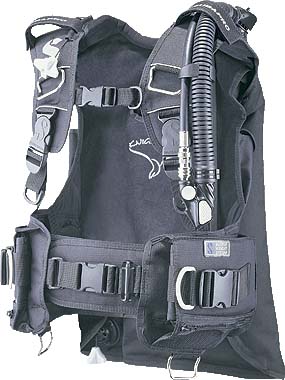 The Scubapro Knighthawk, also available in a special "Ladyhawk" version for female divers, is a robust and comfortable back flotation jacket with a variety of performance features designed for easy wearability and handling. The air bladder placement on the back provides freedom of movement around the chest and shoulders. Those used to jacket style BCs may find a back floatation design such as the Nighthawk much less restrictive.
The Scubapro Knighthawk, also available in a special "Ladyhawk" version for female divers, is a robust and comfortable back flotation jacket with a variety of performance features designed for easy wearability and handling. The air bladder placement on the back provides freedom of movement around the chest and shoulders. Those used to jacket style BCs may find a back floatation design such as the Nighthawk much less restrictive.
The Knighthawk can accommodate up to 24 pounds of weight in its patented quick release weight system. Two trim pockets in the rear provide counterbalance to the front weight so there will be a well-balanced swimming position. Comfort and fit are achieved via an anatomically shaped harness, patented of course, a soft neoprene neck roll and a padded back. The cummerbund, also firmly padded, provides depth compensation. All of these features also distinguish the Ladyhawk version which has a gender-specific cut and design that is anatomically formed for the female shape.
|
